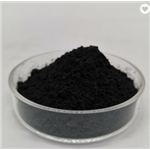Fullerene C60: biological features, ROS generation and quenching and ROS-dependent biological effects
Jan 12,2024
General Description
Fullerene C60 is a unique molecule with antioxidant and pro-oxidant properties. It can efficiently quench various free radicals and generate highly reactive singlet oxygen when exposed to light. However, its low water solubility and derivatization procedures complicate its behavior in biological systems. Fullerene C60 can generate singlet oxygen and superoxide anion, but its ROS-quenching capacity is limited. It can penetrate cell membranes and cause direct reactions with cellular components, leading to cytotoxicity mediated by ROS accumulation. However, fullerene derivatives show promise in anticancer and antimicrobial applications, as well as in treating oxidative stress-mediated neurodegenerative disorders. Overall, fullerene C60 and its derivatives have ROS-dependent biological effects, making them potential candidates for biomedical applications.

Figure 1. Fullerene C60
Biological features
Fullerene C60 is a unique molecule that exhibits both antioxidant and pro-oxidant properties, making it a promising candidate for the development of cytoprotective or cytotoxic anticancer/antimicrobial agents. Fullerene C60 functions as a ‘‘free radical sponge’’, efficiently quenching various free radicals more effectively than conventional antioxidants due to its delocalized p double bond system. However, illumination of Fullerene C60 with visible or UV light causes it to transition to a long-lived triplet excited state and generate highly reactive singlet oxygen (1O2), which can react with biological targets and cause cell damage. Thus, the potential ROS-dependent toxicity of Fullerene C60 must be thoroughly explored and controlled to ensure biocompatibility in drug-delivery or tissue-scaffolding systems, as well as in consumer products. However, the investigation of these issues has been complicated by the low water solubility of Fullerene C60 and the fact that derivatization procedures can alter its photophysical properties and ROS-generating/quenching capacity. Additionally, while the diameter of the fullerene molecule does not meet the size criteria for nanoparticles, many fullerene preparations in solution form nanoscale aggregates with different properties, further increasing the complexity of fullerenes’ behavior in biological systems. 1
Fullerene C60-mediated ROS generation and quenching
Fullerene C60 is a molecule that has unique electron configurations, making it an efficient generator of singlet oxygen and superoxide anion. Singlet oxygen is generated through the process of photosensitization, where fullerene C60 absorbs light in both the UV and visible regions of the spectrum. The singlet excited state of fullerene C60 undergoes intersystem crossing to triplet state, which is efficiently quenched by molecular oxygen to generate large amounts of singlet oxygen. Additionally, fullerene C60 can also transfer an electron to molecular oxygen, forming superoxide anion radical O2. This reaction occurs in polar solvents, particularly in the presence of reducing agents. However, despite its ability to generate singlet oxygen and superoxide anion when photoexcited, fullerenes are weak quenchers of singlet oxygen and have not demonstrated significant scavenging capacity towards major oxygen-centered radicals. It is likely that the ROS-deactivating capacity of various fullerene preparations might not be entirely related to the fullerene core itself, but also to the attached functional groups or various modifying agents introduced to provide water solubility. Further research is needed to understand how different solubilization procedures can affect the performance of fullerenes as ROS-producing and ROS-quenching agents in various biological settings. 2
ROS-dependent biological effects
Fullerene C60 and its derivatives have the ability to penetrate cell membranes and generate singlet oxygen through energy transfer to molecular oxygen, leading to direct reactions with various cellular components. However, their potential use in biomedicine and consumer products is limited by their toxicity, which is mediated through ROS accumulation. The cytotoxicity of non-derivatized C60 nanoparticles can be prevented by antioxidant treatment, and the extent of functional group attachment influences its cytotoxicity. Fullerene derivatives show promise in anticancer and antimicrobial applications due to their ability to photosensitize molecular oxygen to ROS. They also have antioxidant and cytoprotective activities and can associate with mitochondria to quench ROS more efficiently than conventional antioxidants. This makes them potential candidates for treating oxidative stress-mediated neurodegenerative disorders. In addition to deactivating classical ROS, fullerene derivatives can directly quench nitric oxide, modulating its biological functions. Overall, fullerene C60 and its derivatives have ROS-dependent biological effects, including cell damage, cytotoxicity, anticancer activity, and antioxidant/cytoprotective activity, making them potential candidates for various biomedical applications. 3
Reference
1. Krusic PJ, Wasserman E, Keizer PN, Morton JR, Preston KF. Radical reactions of c60. Science. 1991;254(5035):1183-1185.
2. Markovic Z, Trajkovic V. Biomedical potential of the reactive oxygen species generation and quenching by fullerenes (C60). Biomaterials. 2008;29(26):3561-3573.
3. Shershakova N, Baraboshkina E, Andreev S, et al. Anti-inflammatory effect of fullerene C60 in a mice model of atopic dermatitis. J Nanobiotechnology. 2016;14:8.
- Related articles
- Related Qustion
- fullerene c60 in skincare Feb 2, 2023
Fullerene C60? in a special form packed (with technology encapsulation) is present in the Hyaluron molecule to allow dispersion in water, as Fullerene C60 is normally insoluble in water.
Guanidine carbonate has versatile applications due to its strong organic alkali properties, but requires careful handling due to potential health hazards and harm to aquatic life.....
Jan 12,2024APIBoron nitride-based nanocomposite hydrogels offer biodegradable, biocompatible properties for wound healing, cancer treatment, and controlled drug delivery in medical applications.....
Jan 12,2024APIFullerene C60
99685-96-8You may like
- FULLERENE
-

- $55.00 / 1g
- 2024-06-04
- CAS:99685-96-8
- Min. Order: 20g
- Purity: 99%
- Supply Ability: 300tons
- FULLERENE
-

- $1.00 / 1g
- 2024-06-04
- CAS:99685-96-8
- Min. Order: 100g
- Purity: 99%
- Supply Ability: 600tons
- Fullerene C60
-

- $145.00 / 1G
- 2024-06-04
- CAS:99685-96-8
- Min. Order: 1G
- Purity: 99%
- Supply Ability: 5000




